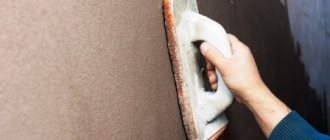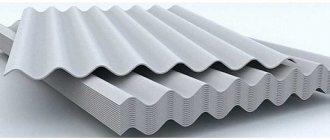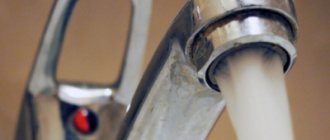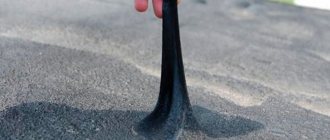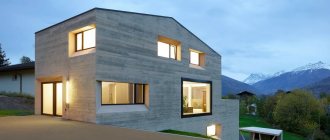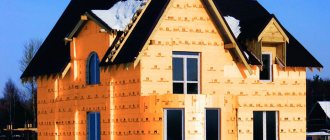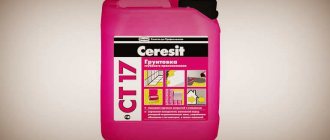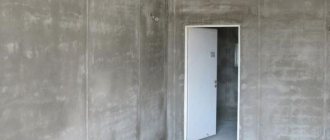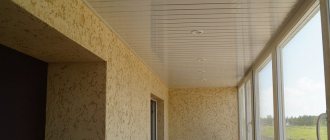Puttying concrete walls has now established itself as the most common method of leveling surfaces, in particular: walls, floors and ceilings made of concrete.
Concrete is a very specific material. Its main feature is its low degree of hygroscopicity. Concrete almost does not absorb moisture, which interferes with its adhesion to other building mortars.
Plaster or putty penetrates the pores and crevices on the surface to be finished, thereby providing adhesion, but in concrete there are very few such irregularities, so adhesion is quite difficult to achieve.
Characteristics and purpose
Putty is a composition that is a thick paste-like mixture or powder intended for leveling surfaces. There are putties for different types of surfaces, including separately for concrete.
Thanks to putty, a durable and even coating with good adhesion is formed on the surface, making it possible to further finish the base, for example, glue wallpaper or apply paint.
The putty contains a filler and a thickener. The filler consists of barite, talc and chalk. In addition, the composition may contain pigmenting substances, including ocher and zinc white. Both of these pigments act as an addition to the film-forming substance.
Areas of application of putty compositions:
- restoration work on concrete and reinforced concrete structures that have fallen into disrepair over time,
- standard work on leveling concrete bases before laying waterproofing materials or applying finishing,
- leveling of defects existing in crushed stone nests and seams,
- processing of concrete in tunnels, trenches, viaducts, on railway tracks.
In other words, wherever there is concrete, you can’t do without putties.
Preparing the wall surface for putty
The main thing is to make sure that the surface of the walls is absolutely clean. Be sure to remove stains of grease, paint or soot. Of course, there should be no falling layers of plaster, residues of scale, wax or parts of the formwork. Don’t even start puttingty on frozen ceilings and walls. This is strictly not recommended.
Before applying putty, coat the walls with a primer. This will ensure good adhesion (connection) of the putty solution to the walls. Prime the surface using a special roller. Try to apply the primer solution evenly, avoiding gaps. One layer is enough.
There are the following types of putty: finishing, lighthouse, starting. Let's look at the properties and scope of application in detail.
Requirements for compositions
Concrete structures are often operated under conditions of multiple environmental influences. Mechanical loads, humidity, aggressive chemical environments, wind, temperature changes - all these factors in themselves can lead to the gradual destruction of the material. Therefore, the putty should be such as to protect (create a barrier) the material from the external environment to the maximum extent possible. In addition, puttying should improve the adhesive properties of the surface, because often concrete structures are subject to further finishing work.
So, a good putty should be characterized by the following qualities:
- durability of the coating (resistance to friction and other mechanical loads),
- reliable adhesion,
- moisture-proof qualities,
- fire safety,
- non-toxic,
- resistance to chemicals,
- resistance to low and high temperatures, as well as sudden temperature changes,
- long service life.
Concrete compositions also have disadvantages:
- It is impossible to glue concrete covering layers to the substrate.
- Not all defects can be removed - we are talking only about small irregularities.
- The job requires some experience.
- In case of flooding, the moisture resistance of the coating will still not be enough.
When choosing putties, it is recommended to pay attention to the following qualities:
- adhesion,
- purpose of a specific composition (is it suitable for concrete),
- percentage of moisture resistance,
- vapor permeability (will the coating allow moisture to circulate).
Types of putties
Based on the nature of their use, putties are divided into three groups:
- Basic - used for application directly to a concrete surface.
- Finishing - used as a top layer, on which finishing work will be carried out in the future.
- Universal - can be used both as base and finishing.
Base mixtures
Starting (or base) putties are used at the very beginning of puttying, when you need to level the concrete surface. Such compositions are applied in as thick a layer as possible. Starting mixtures are most often produced in powder form. It is the fact that the base mixtures are offered in powder form that explains such great attention to the correct preparation of the finished composition. The final product should have elasticity and not be too thick or runny.
As a rule, one coat is not enough to create a reliable starting coating. When the first layer dries, the coating must be sanded and then additional layers must be applied. As an example of a high-quality putty composition from this group, we can mention the “Starateli” brand.
Finishing mixtures
This group of mixtures is intended for the final processing of an already puttied coating. The task of the finishing composition is to make the surface as even and smooth as possible. The finishing mixture is applied in a thin layer, which is applied to the already polished concrete. An example of a high-quality putty is the Ceresit brand, which has a whole series of finishing grades for concrete.
Universal mixtures
The name eloquently suggests that putties of this group can be used for both initial and finishing treatment of concrete. However, any versatility is fraught with the loss of qualities inherent in specialized compounds. In addition, the cost of such mixtures is higher than that of specialized options. The most famous representative of the group of station wagons can be considered such a well-known brand as “Novol”.
Composition of putties
There are many mixtures of different compositions, which are produced on the basis of the following components:
- cement,
- lime,
- gypsum,
- adhesives,
- paint and varnish compositions,
- oils,
- polymeric substances (including latex and acrylates).
Cement mixtures
Cement-based compositions are considered the most common on the market. Cement acts as a binding component. The brands used are M500 and M400.
The advantages of cement mixtures include:
- moisture resistance,
- low cost.
There are many more disadvantages:
- High shrinkage, which means the coating dries out and cracks.
- Increased material consumption, which is also a consequence of shrinkage.
- Insufficient elasticity of the coating.
- Inability to create truly smooth finishes.
- Low work productivity.
- Tendency to swell in case of contact with wood.
The most famous brands of cement putties include Knauf, Ceresit, Ilmax and others.
Gypsum mixtures
The compositions of this group are made on the basis of gypsum. The best known putty is gypsum mixture, which is considered the best choice for dry rooms. At the same time, gypsum can also be used for moderately damp rooms.
Other advantages of gypsum compositions include:
- possibility of working with plastered surfaces,
- good thermal insulation,
- quick drying,
- fire resistance,
- affordable prices,
- non-toxic.
Mixtures of this group also have disadvantages:
- Not suitable for processing façade parts of buildings.
- Do not use for puttying in very damp areas (for example, in swimming pools or bathrooms).
- The coating is very fragile and susceptible to mechanical damage.
- The coating does not tolerate temperature changes well.
- Gypsum promotes the development of metal corrosion.
The most famous brand of gypsum putty is the German mixture “Knauf Fugen”, which is distinguished by the presence of many different qualities. In particular, this mixture can be used as a putty for ceilings on concrete, a universal or finishing composition.
Polymer mixtures
Polymer-based compounds are a common name for latex and acrylic putties. Polymers make it possible to create high-quality plastic coatings. However, the cost of polymer mixtures deters many potential users. It should be noted that high prices are partly justified by the significantly lower consumption of polymers. It is also worth noting the large number of fakes on the market.
Latex putties
Latex-based mixtures are rarely used for concrete. Their main purpose is to process plasterboard sheets. However, some latex mixtures can be used to level and improve the surface of concrete structures.
Among the positive properties of latex it should be noted:
- elasticity,
- possibility of applying even a very thin layer,
- no shrinkage,
- excellent adhesion to dissimilar materials,
- ease of use.
Disadvantages of latex:
- impossibility of increasing the layer thickness (coating does not exceed 3 millimeters),
- inadmissibility of drafts,
- radical deterioration of performance at low temperatures,
- high price.
Acrylic putties
Acrylate-based concrete floor putty can be used both for treating facades and inside buildings. Acrylic is perfect for puttingtying concrete.
Advantages of acrylates:
- very thin layer, which is good for finishing compositions,
- good design effect,
- elasticity,
- no shrinkage,
- decent adhesion,
- resistance to humidity and temperature changes.
Well-known brands of concrete putties are Rotband Finish and TRIORA.
Smooth walls in a panel house. Is it necessary to plaster?
No registered user is viewing this page.
15 useful accessories to keep your kitchen tidy
Kitchen apron made of tiles: simple and non-standard design ideas
Choosing furniture for the kitchen
- Construction and repair
- Foundation
- Roof
- Walls
- Window
- Doors and partitions
- Ceiling
- Balconies and loggias
- Internal structures
- Floor
- Water supply and sewerage
- Heating
- Ventilation and air conditioning
- Gas and energy supply
- Lighting
- Plumbing equipment
- Security and home automation
- Baths, saunas, swimming pools
- Construction Materials
- Decoration Materials
- Tools
- Technique
- Laws and finance
- TechnoNIKOL
- Design and decor
- Apartment
- Bedroom
- Kitchen
- Dining room
- Living room
- Bathroom, toilet
- Hallway
- Children's
- Attic
- Small rooms
- Workplace
- Wardrobe
- Library
- Decoration
- Furniture
- Accessories
- Vacation home
- Landscape
- Redevelopment
- Catalog of houses
- Magazine
- News
- Events
- about the project
- Advertising on the website
- Advertising in a magazine
- Terms of use
- Contacts
- about the project
- Advertising on the website
- Advertising in a magazine
- Terms of use
- Advertising on the website
- Advertising in a magazine
- Terms of use
- Contacts
A few caveats
When working with concrete putties, it is recommended to follow certain rules:
- If the surface is too smooth, it is necessary to give it some roughness. This can be done by creating notches. In some cases, reinforcement is even used.
- It is not allowed to pour putty compounds into the formwork. This will do nothing in terms of the putty fulfilling its intended purpose.
- The mixture contains all the necessary additives, and their presence does not contradict the proximity with other components of the solution. You cannot add additional components (including cement) to the mixture, as this will only worsen the quality of the original.
- If the putty has started to set in the container, there is no point in trying to stop the process by adding water. If time has already been lost, it is better to throw away the batch that has become unusable and make a new batch.
- It is necessary to monitor the air temperature during puttying. The packaging always indicates the minimum ambient temperature at which work is allowed. The typical minimum level is 5 degrees above zero, although there are compounds with a minimum level of 3 degrees Celsius. In this case, the minimum temperature at which the finished surface can be used does not matter (even if we are talking about 40 degrees below zero). It is the minimum indicator when puttying that is important.
Application technology
Puttying of concrete walls is carried out in several stages:
- Treatment of concrete base. First of all, we remove the old coating (or its remains). We widen the existing cracks with an electric drill until the concrete breaks off easily. We remove dust, dirt, oil stains and other foreign substances from the surface. Using cement mortar, we repair defects in the floor or walls, and then wait for the surface to dry.
- Priming a concrete structure. Clean the surface again. Consistently apply two layers of primer. At the same time, before each next stage, we wait until the primer is completely dry.
- Mixing the solution. The putty composition is prepared according to the recipe specified by the manufacturer on the packaging. The optimal proportion of powder is considered to be 1/5 part in relation to water. The solution can be used within 3-5 hours after the end of the batch. The method of stirring largely depends on the available volume of putty. A small container can be handled with a standard mixer, but to mix 25 kg or more you will need a concrete mixer. When stirring, avoid introducing excessive air into the solution.
- Puttying. Pour the solution onto the surface and spread it with a spatula. To increase the strength of the surface, we use reinforcing mesh. We wait for the first layer to dry and apply an additional amount of material. The final hardening of the coating occurs after about a day (or even more - the period depends on the depth of the defects).
- The final stage is removing small irregularities using sandpaper.
Advice! It is recommended to pay attention to the manufacturer's recommendations regarding putty consumption per square meter of concrete surface at a certain layer thickness. This will optimize material costs.
Putty is an excellent tool to protect concrete and facilitate further finishing work. It is recommended to carefully study the characteristics of the mixture in advance in order to select the appropriate composition for specific operating conditions.
Can putty be applied to concrete surfaces?
Advice
If the concrete surface does not require preliminary leveling, then it can be puttied without prior plastering.
It is recommended to lay reinforcing material (fiberglass). It will increase adhesion and prevent cracking of the putty. This is true for porous concrete.
Walls
Puttying of concrete walls is not much different from the standard one .
It is important to pay attention to the compositions used and the type of room. Concrete must be dust free and degreased. Depending on the type of finish, the final coat may need to be sanded with fine sandpaper. For dry rooms (bedrooms, living rooms, hallways) you need gypsum putty; for wet rooms, it would be correct to use cement or acrylic putty. Porous substrates that do not require leveling can be puttied with thixotropic non-shrinking compounds. Fiberglass is pre-laid. Cracks and seams are filled with starting solution. If the defects are minor, then 2-3 layers of finish are allowed without laying the start.
Attention
Instead of soil, concrete contact is used on concrete walls, since it does not reduce moisture absorption.
Ceiling under wallpaper or paneling
Fiberglass is laid on the ceiling before puttying, especially plasterboard . It can be cut into several fragments and overlapped. Installation is carried out on a layer of starting putty. It will take 3-4 layers to cover the web. When puttying under wallpaper or paneling, you don’t have to eliminate significant defects and don’t make the background white.
If a concrete ceiling needs restoration, then it is better to use acrylic mixtures.
Floor
Floor putty must have increased strength, as it will be subjected to heavy loads every day. Here you need a cement or special composition. For further sanding of floors, a waterproofing mixture is used. The surface is cleaned with a construction vacuum cleaner. The mixture is poured onto the floor, then leveled with a brush or spatula.
For painting
The peculiarity of preparation for painting is the creation of a uniform, perfectly flat surface without defects . Acrylic putty is recommended, since polymer compositions can be tinted in the mass. This technique is used to add color saturation.
Other features of puttying for painting:
- mandatory grinding of the finishing putty coating;
- applying at least 4 layers of composition to cover fiberglass;
- the use of white mixtures - putty and primer;
- laying fiberglass end-to-end with overlapping seams on the base.
Attention
Each layer for painting can be applied up to 1 mm thick. The maximum coating density is 10 mm.
A covering primer is necessary if the solution produces a yellow or grayish tint. Otherwise, a universal penetrating one is used. The concrete is directly processed using concrete contact.
